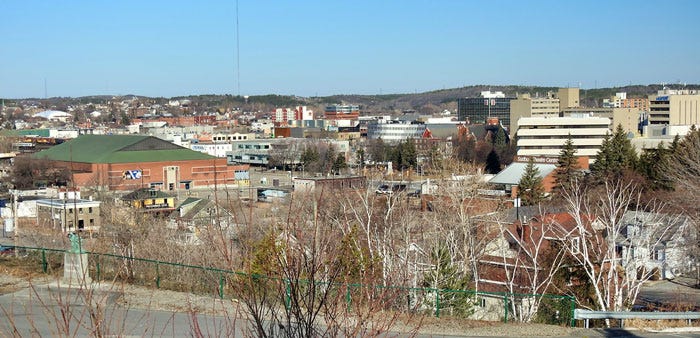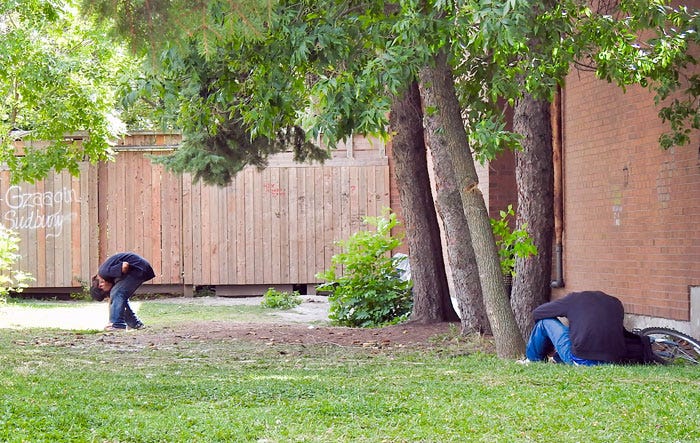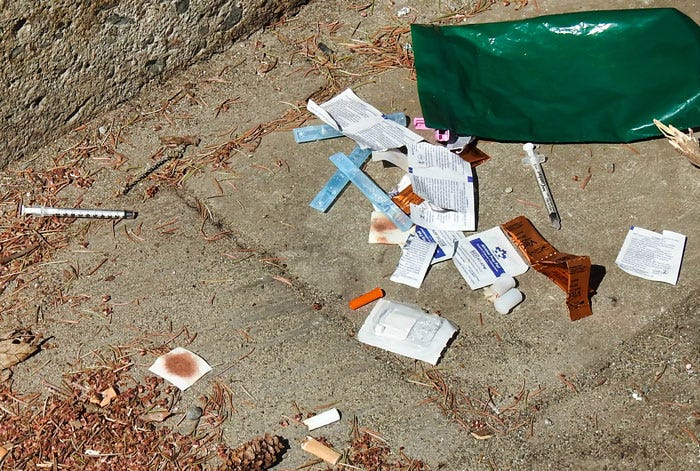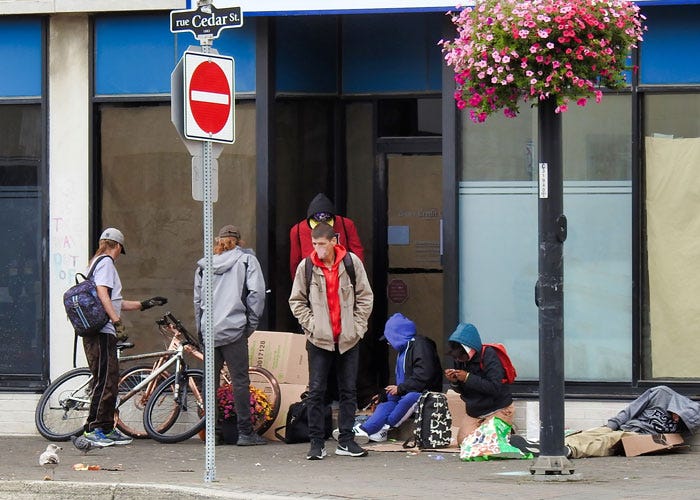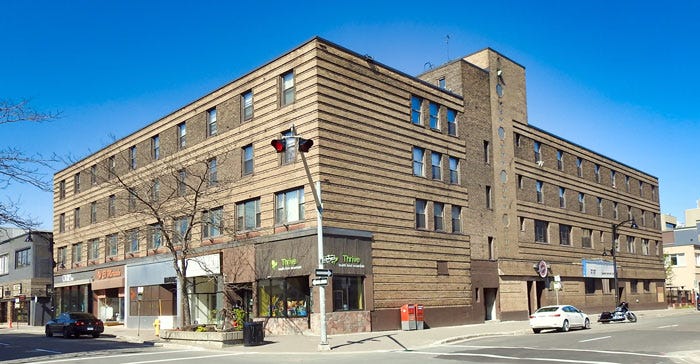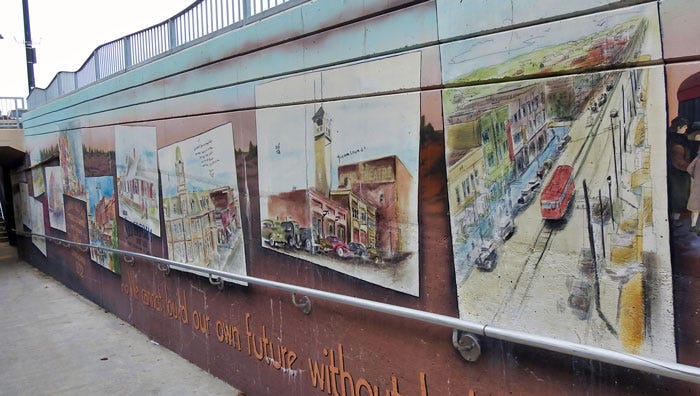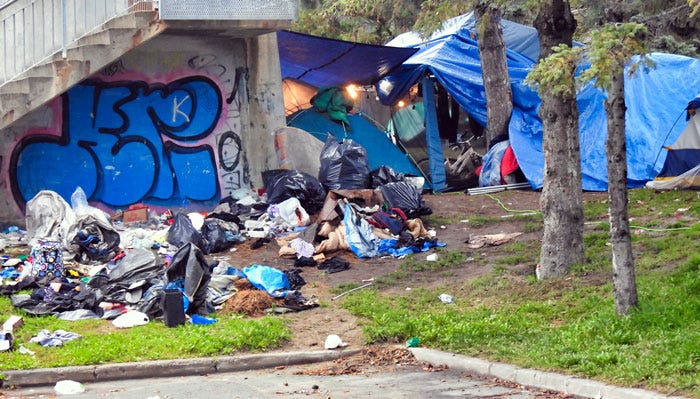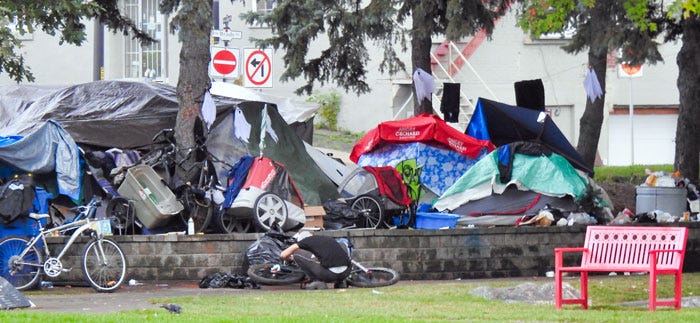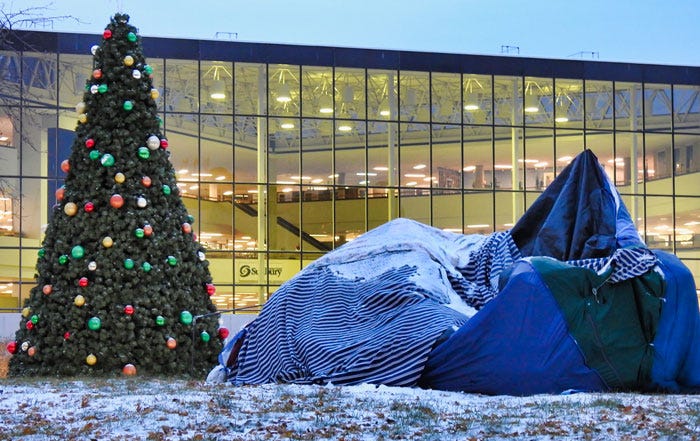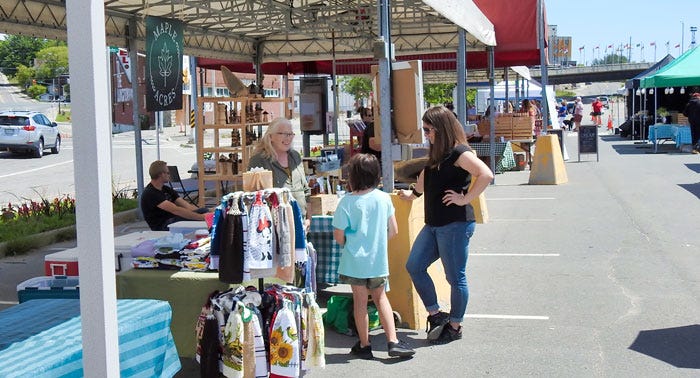Sudbury's homeless and the downtown
Greater Sudbury is trying to deal with the drug addiction crisis.
Downtown Sudbury is where the city’s homeless drug addicts, the mentally ill, alcoholics, malingers and vagrants congregate. Their social and medical services are located here and that is where the addicts openly buy and use illegal drugs.
The Sudbury District has one of the highest levels of opioid-related deaths, per capita, in Ontario.
The addicts presence in the small city core, creates tensions with the city’s businesses and retail stores due to acts of vandalism, theft, shoplifting, public excreta, littering, loitering and begging (panhandling).
Used needles and drug paraphernalia in Tom Davies Square (September 2022)
Open drug dealing and use in the downtown results in needles, drug paraphernalia, and small pieces of blackened aluminum foil littering the city core. Acts of violence, including stabbings and murder, are reported in the local news.
These anti-social behaviours alarm many people so they avoid going downtown.
A common sight on Cedar Street
A brief description of the downtown
Sudbury was built as a temporary work camp in 1883 for the Canadian Pacific railway that runs from Halifax to Vancouver. It is in a valley that is surrounded by tree-covered rocky hills. After nickel and other minerals were discovered, Sudbury was incorporated as a town and then as a city
The downtown is a small triangle (∇) that is six short blocks tall and five wide. As you go south, it narrows until it ends as just a point between Elgin and Paris Streets.
It consists of government and court buildings, professional offices, mixed retail-residential buildings, a large park, churches, medical offices, clinics, pharmacies, and social services.
It also has a large YMCA, a French language cultural centre, an architecture school, and the Sudbury Community Centre. (Home of the OHL Sudbury Wolves).
There are two hotels and a close-to-dead indoor shopping mall-office complex.
A strip of restaurants, bars and nightclubs is located in the south part of the downtown. It is Sudbury’s version of Toronto’s Queen Street West Entertainment District and this part of the downtown is busy on Friday and Saturday evenings.
The downtown also hosts the city’s homeless population and all of their support services that are provided by various public health, welfare, city agencies and Non-Government Agencies (NGOs).
Happier times
Fifty years ago, the downtown was the shopping destination for the people who lived in the city and in the nearby smaller communities. However, times changed and new shopping malls opened in the Four Corners area, to the south of the downtown.
New Sudbury, which is north of the downtown, has a large indoor shopping mall, multiple strip malls and the most of the city’s big-box stores.
Since then, a number of downtown buildings have been torn down and are now parking lots or have been left empty. There are a number of retail stores that are for lease and buildings up for sale.
The hollowing out of the downtown core
The hollowing out of the business core is not unique to Sudbury. Over the last forty years, it has occurred in most Canadian cities as large suburb shopping malls, big box stores and online shopping has given consumers more shopping options.
The residents who live north and south of the downtown have nearby medical labs, dentist and doctor offices, bank branches, a good selection of grocery and hardware stores and restaurants. They have Canadian Tire and Wal-Mart stores, Beer and LCBO outlets and car dealerships. For most of their shopping and service needs, they don’t have to go downtown.
The homeless
In 2021, following the “Housing First” theory, that was put forward by homeless advocates, the city allowed tent encampments to remain on public property in the city core. Social activists believe that tents should be a short-term solution until the squatters could be placed in permanent housing.
However, the number of squatters increased and the amount of drug addicts and the discarded drug supplies, trash, stolen bicycles, thefts and vandalism turned Memorial Park and Tom Davies Square (city hall) into third-world slums.
Sudbury’s longest lasting Covid-19 outbreak occurred in Memorial Park.
The park looked so bad and was considered so unsafe that in 2021, the local branches of the Royal Canadian Legion cancelled their November 11 outdoor civic Remembrance Day ceremony at Memorial Park.
A tent in Tom Davies Square, beside city hall December 2021
In the spring of 2022, the city realized that change was needed. The city removed all of the remaining tents located in the downtown area.
Can the downtown recover?
The Downtown Business Improvement Association (BIA) is working hard to attract shoppers to the downtown. There are regular cultural activities, weekend concerts and shopping promotions to help the independent retailers and services.
During the summer months, the Sudbury Market is held every Saturday on Elgin Street. It attracts large number of shoppers as it features produce and meats from local farmers, baked goods and local crafts.
The city is helping. It cleaned and repaired the damaged landscaping in the downtown public areas and restored electrical and water services in Memorial Park. The streets and the public spaces are now notably cleaner and the police increased their number of focused patrols in the downtown area by 168%.
Local restaurants have large outdoor patios during the summer months.
Zero Vacancy is a program that offers entrepreneurs month-to-month downtown retail space with inexpensive rental rates. The BIA includes complimentary business insurance.
Recognizing that improvements have been made, the Legion held their November 11, 2022 service at Memorial Park.
Where do we stand?
The owners of the commercial and retail businesses cannot not leave the downtown and neither will Sudbury’s homeless. The city politicians need to close the downtown drug dealing, reduce the number of addicts living rough on the streets and make the downtown a place where all feel welcome and safe.
Future essays:
• The case for public toilets.
• Why the downtown needs more shelter spaces, not public toilets.
• Defensive architecture Part 1 to 6.
• Police need to crack down on thefts.
• Why Housing First and Harm Reduction doesn’t work.
• Who owns the drug addiction problem?
• Ever wonder why the number of homeless drug addicts never goes down?
• The drug addiction services industry.
• What are the NGOs written measureable objectives?
• No one should be turned away from a shelter due to not enough beds.





